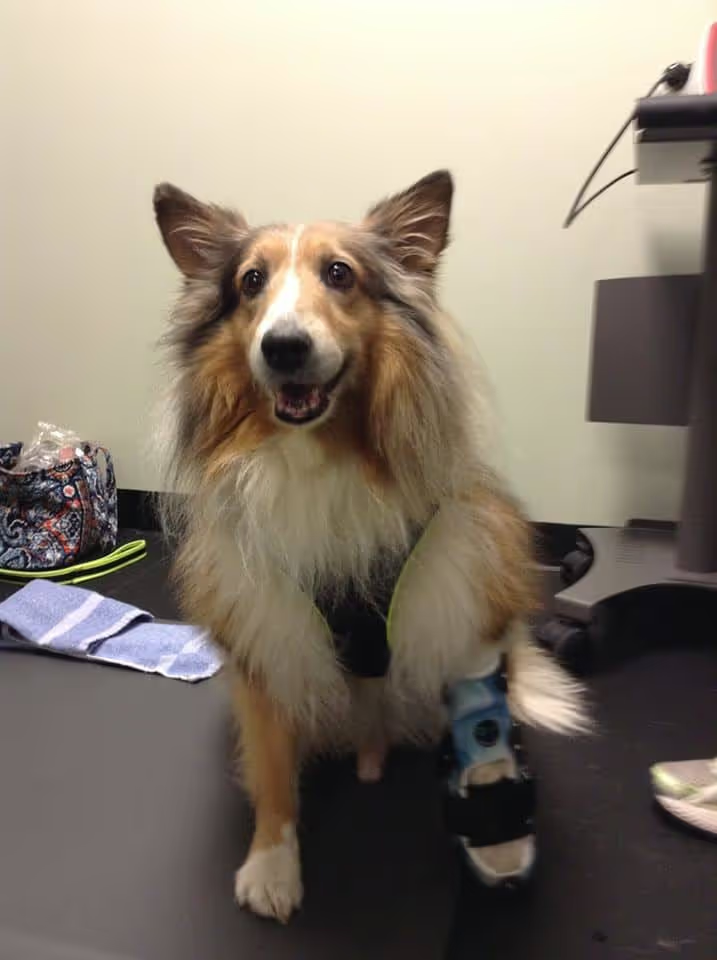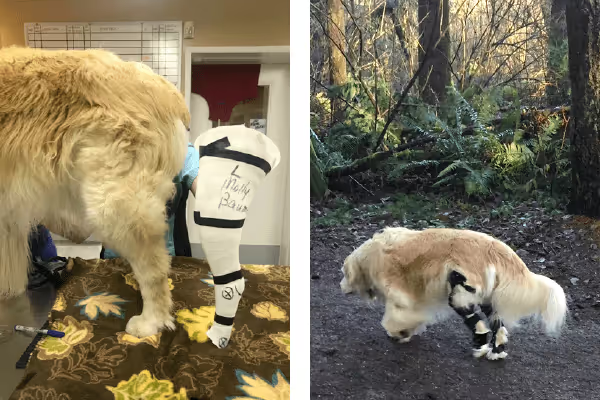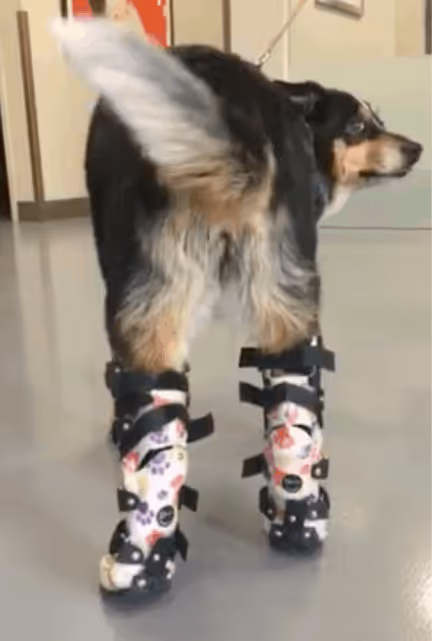Must We Have A Paw Segment, Really? OrthoPets Paw Segments
Must We Have A Paw Segment, Really?

Paw segments! They are clunky and chunky, and they hurt when you get stepped on with them! Ever wonder why they are necessary? It all comes down to physics and toes (digits). The severity and location of the injury dictate “to paw or not to paw". Rest assured we do not add a paw segment unless medically necessary.
Circumstances requiring a paw segment due to paw injuries
- Digit (toe) amputation causing malformation of remaining digits (supination, pronation, collapse of the digital arch)
- Loss of flexor tendon function. This can be from tendon failure and “weak” digits or from tight digits (so-called crab-claw paw). Either way this means an inability to push off of the ground with each stride. Try to walk without using your toes; this is like walking without digital flexors to help you push off the ground. Now try to walk in a high heel shoe with one heel broken off; this mimics the crab-claw scenario. Your heel falls, and you hyperextend your knee.
- All digits missing or amputated. This is a pseudo prosthesis. It’s a hybrid between an orthosis and a prosthesis.
- Wounds associated with the paw: e.g. tumors, chronic wounds from friction.
Circumstances requiringa paw segment when the paw is normal
- Short metacarpal bones relative to the antebrachium (area from elbow to carpus). The ideal ratio is 1:3 metacarpals to antebrachium. A longer antebrachium is a mechanical disadvantage.
- Short metatarsal bones relative to the crus (area from stifle to tarsus). The ideal ratio is 1:3 metatarsal to crus. A longer crus is a mechanical disadvantage.
- Severe hyperextension of the carpus (palmigrade collapse) or hyperflexion of the tarsus (plantigrade collapse).
- More than one plane of instability (planes are sagittal, frontal, transverse). The transverse plane (rotation) is particularly difficult to control without a paw segment. The paw segment allows direct contact of the device to the ground providing control over rotation.
- Big dewclaws or multiple dewclaws that will be injured by the orthosis without a paw segment. This is most commonly encountered with the pelvic limb. Suspension of the device without a paw segment isby the metatarsal/carpal heads. Dewclaws may lie directly over these structures and the risk for serious wounds is high.
A little more about physics and control of instability:
- The paw segment gives us direct contact to the ground. This is important when the patient can’t control instability in rotation or in terms of pronation/supination arising from severe varus or valgus. Without the paw segment, the paw itself contacts the ground and moves the limb within the device; instead of the device and the limb working together, they fight each other. Such rotation creates friction wounds and soft tissue strains. Imagine trying to ski with your bare foot merely taped to a ski. Your foot and ankle are not controlled and the ski can rotate your foot as it makes contact with the ground. This is why we use rigid boots to ski: rigid contact of the foot and ankle. Another good example is walking in deep sand in a flipflop sandal. It’s difficult to keep your heel from slipping off (rotating) the sandal; to stop this you need to have your entire foot in a solid shoe.
- The paw component lengthens the lever arm. Whenever joint instability must be controlled, the longest lever arms are best. Lever arms are the segments above and below the joint. Longer lever arms provide more control with less force. Think about trying to break a stick in two. Where are your fingers? As far away from your thumbs (fulcrum or joint) as possible. If you put your fingers close to the center you must push harder to break the stick and that’s more painful because more force is required. Now try with one hand at the end of the stick (long lever arm) and one closer to the center (short lever arm); you must push harder on the short lever. This last example is like the patient without a paw segment; a long lever arm coupled to a short lever arm. The short lever arm represents the metacarpal or metatarsal bones and the skin of your fingers represents the skin just above the paw. Painful! At best you achieve poor control of joint instability and at worst the skin breaks down due to excessive friction and pressure.
The disadvantages of paw segments and are they worth it?
- YES! If we have properly analyzed the case and come down on the side of a paw segment then the tradeoff is worth it.
- Disadvantages and how to solve them
- Mud and snow collect in the paw segment: We can make a gaitor to cover the paw segment. Ask your case manager about OP-gaitors.
- Bolts scratch the floors in the house: We can reverse the tread application and cover the bolt or use boltless tread.
- Tread has to be replaced: In many cases simple bike tire can be used as an inexpensive replacement. Ask your case manager how this is done.
- Some dogs kick the contralateral leg with the paw segment: We can make an OP splint boot to cover the other limb, pad the inner side of the paw segment, and rehabilitation can teach your dog to walk with a wider stride.
- The paw segment makes the leg longer: This is true! We call this a limb length discrepancy (LLD).
i. The good news is the increased length is minimal (5-12 millimeters) depending on the size of patient.
ii. This is nearly insignificant relative to 1) the full length of the leg and 2) the severe LLD caused by an uncorrected instability.
iii. Because animals are quadrupeds (4 leg) the consequences of a slightly longer leg are less significant than in people because compensation is distributed over more legs.
Can the paw segment ever come off? Sometimes yes……
- With recovery of dorsiflexion of the digits. This means a normal flat paw in which all paw pads touch the ground in stance.
- With improvement in instability (e.g. hyperextension, varus, or valgus, or healing Achilles tendon). Significant improvement is required.
- Healing of fractured bones. (e.g. metacarpal/metatarsal bones, phalanges)
- Your veterinarian in consultation with our OrthoPets V-OP specialists will make this decision.




